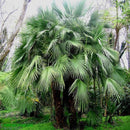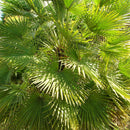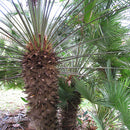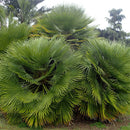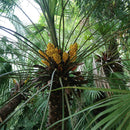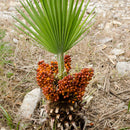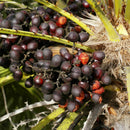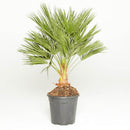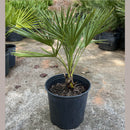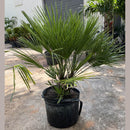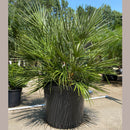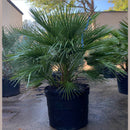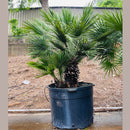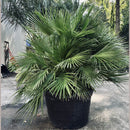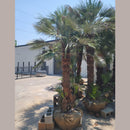| Grows Well In Zones: | 4-11 Patio / 8-11 Outdoors |
| Mature Height: | 8-15 ft |
| Mature Width: | 6-10 ft |
| Sunlight: | Indoors: Bright Indirect Light Outdoors: Full Sun to Partial Shade |
| Growth Rate: | Slow |
| Shape: | Tree |
| Placement: | Indoors, Patio, Outdoors |
Most Versatile Cold-Hardy Palm
The European Fan Palm was awarded the Horticulturist Award for Garden Merit because of its availability, adaptability, ease of growing, pest resistance, and outstanding beauty. It gets its praise not only because of its unique look resembling a sculpture, but also because it is so easy to care for.
Besides adding an instant tropical appeal, European Fan Palms are cold-hardy down to 20°F with short drops to 10°F, drought-tolerant, resistant to pests and diseases, slow-growing and don’t require much in the way of maintenance to look fabulous. The palm also graces the landscape with its year-round lush greenery and deep green color, upgrading any landscape with its striking beauty.
Medium in size, European Fan Palms slowly grow to a mature height of 8-15 ft and 6-10 ft wide. They are sure to stand out in the landscape with their bushy canopies of fan-shaped fronds filled with finger-like and deeply divided leaflets. Each blue-green or grayish-green frond grows around 2 feet long and wide and is attached to a leaf stalk that is around 4 feet long.
Its brown curving trunks are part of its appeal, they resembles a pine cone as they’re lined from top to bottom with scales. As the palm matures it develops multiple trunks, or it can be trained to become a single trunk specimen. As if that were not enough, panicles of bright yellow flowers that bloom in spring. The spent flowers develop into small round orange or yellow fruits that ripen to brown in fall
European Fan Palms have evolved to survive the hot dry summers and cooler winters in Europe, making them perfect for places with mild winters and hot summers. It is no wonder the European Fan Palm won the Garden Merit award, as it is a medium sized, easy maintenance beauty that will adapt and look good in almost any landscape.
This palm is perfect almost anyone, it can be trained to be single, double or multi-trunk and you can keep it as full as you desire.
Q: How big do European Fan Palms get?
A: European Fan Palms can grow 8-15 ft tall and 6-10 ft wide.
Q: What is the growth rate for a European Fan Palm?
A: European Fan Palms grow at a rate of 6 inches per year.
Q: What is the difference between the European Fan Palm and the Mediterranean Fan Palm?
A: There is no difference, Mediterranean Fan Palm is just another name for European Fan Palm.
Q: Is the fruit from the European Fan Palm edible?
A: Yes, both the fruit and the heart of the European Fan Palm are edible.
1. Sunlight
European Fan Palms prefer full sun, but they can tolerate locations with partial sunlight as well However, if planted in too much shade the palm will lose its compact shape.
2. Water
- For the first month, water twice a week. After it is established, water once a week unless it rains.
- Watering needs to be thorough to make sure the bottom roots receive water at every watering.
- Space out watering sessions so the roots are able to dry.
- The amount of water needed per palm per watering session is equivalent to the volume of the planting hole that was dug for each palm. This amount may range from 2 gallons for small containerized material to 15 gallons for larger palms.
- Plants in a container need more constant watering than those planted on the ground.
- Overwatering or bad drainage can cause permanent damage to the roots over time.
- Placing mulch over the roots can help with water retention. Use caution not to allow the mulch to touch the base of the palm, otherwise it can cause rot.
Seasonal watering changes
Depending on your geographic location and the intensity of the season, you may need to adjust watering accordingly:
Winter: (60 degrees or less) no need to water, except for the first 30 days after installation.
Spring: (75 degrees or less) Once a week.
Beginning of Summer: (90 degrees or less) Twice a week.
Heat of Summer: (90 degrees and above) Three times a week.
3. Fertilization
European Fan Palms should be fertilized three times a year in the Spring, Summer and Fall. Use a general purpose blend specific to palms, and be sure to follow the instructions on the label.
4. Soil
European Fan Palms tolerate most soils, as long as they drain well. To improve drainage combine 70% soil with 30% coarse sand.
5. Pruning
It is not necessary to prune your European Fan Palm. When a frond dies, it will detach and fall off on its own. If you do decide to prune your palm, be sure to prune the fronds that are damaged to mostly brown. Pruning this palm encourages new growth.
6. Winter Care
If temperatures fall below 15° F, wrap trunk with thick blanket and if possible, wrap incandescent lights around the blanket for added heat.
Customer Reviews
Payment & Security
Your payment information is processed securely. We do not store credit card details nor have access to your credit card information.



























